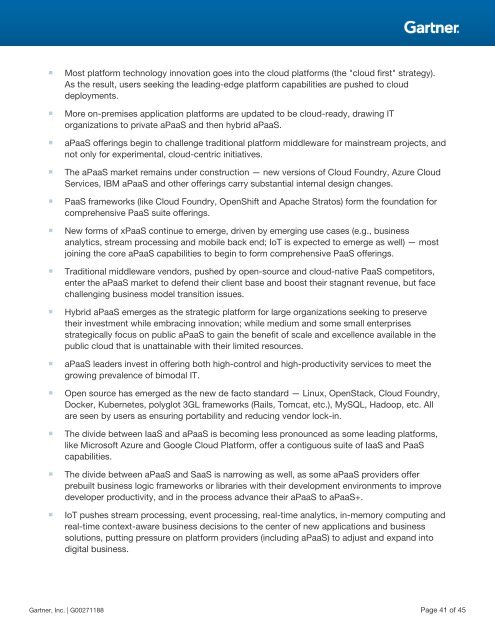Magic Quadrant for Enterprise Application Platform as a Service, Worldwide
Create successful ePaper yourself
Turn your PDF publications into a flip-book with our unique Google optimized e-Paper software.
■<br />
■<br />
■<br />
■<br />
■<br />
■<br />
■<br />
■<br />
■<br />
■<br />
■<br />
■<br />
■<br />
Most plat<strong>for</strong>m technology innovation goes into the cloud plat<strong>for</strong>ms (the "cloud first" strategy).<br />
As the result, users seeking the leading-edge plat<strong>for</strong>m capabilities are pushed to cloud<br />
deployments.<br />
More on-premises application plat<strong>for</strong>ms are updated to be cloud-ready, drawing IT<br />
organizations to private aPaaS and then hybrid aPaaS.<br />
aPaaS offerings begin to challenge traditional plat<strong>for</strong>m middleware <strong>for</strong> mainstream projects, and<br />
not only <strong>for</strong> experimental, cloud-centric initiatives.<br />
The aPaaS market remains under construction — new versions of Cloud Foundry, Azure Cloud<br />
<strong>Service</strong>s, IBM aPaaS and other offerings carry substantial internal design changes.<br />
PaaS frameworks (like Cloud Foundry, OpenShift and Apache Stratos) <strong>for</strong>m the foundation <strong>for</strong><br />
comprehensive PaaS suite offerings.<br />
New <strong>for</strong>ms of xPaaS continue to emerge, driven by emerging use c<strong>as</strong>es (e.g., business<br />
analytics, stream processing and mobile back end; IoT is expected to emerge <strong>as</strong> well) — most<br />
joining the core aPaaS capabilities to begin to <strong>for</strong>m comprehensive PaaS offerings.<br />
Traditional middleware vendors, pushed by open-source and cloud-native PaaS competitors,<br />
enter the aPaaS market to defend their client b<strong>as</strong>e and boost their stagnant revenue, but face<br />
challenging business model transition issues.<br />
Hybrid aPaaS emerges <strong>as</strong> the strategic plat<strong>for</strong>m <strong>for</strong> large organizations seeking to preserve<br />
their investment while embracing innovation; while medium and some small enterprises<br />
strategically focus on public aPaaS to gain the benefit of scale and excellence available in the<br />
public cloud that is unattainable with their limited resources.<br />
aPaaS leaders invest in offering both high-control and high-productivity services to meet the<br />
growing prevalence of bimodal IT.<br />
Open source h<strong>as</strong> emerged <strong>as</strong> the new de facto standard — Linux, OpenStack, Cloud Foundry,<br />
Docker, Kubernetes, polyglot 3GL frameworks (Rails, Tomcat, etc.), MySQL, Hadoop, etc. All<br />
are seen by users <strong>as</strong> ensuring portability and reducing vendor lock-in.<br />
The divide between IaaS and aPaaS is becoming less pronounced <strong>as</strong> some leading plat<strong>for</strong>ms,<br />
like Microsoft Azure and Google Cloud Plat<strong>for</strong>m, offer a contiguous suite of IaaS and PaaS<br />
capabilities.<br />
The divide between aPaaS and SaaS is narrowing <strong>as</strong> well, <strong>as</strong> some aPaaS providers offer<br />
prebuilt business logic frameworks or libraries with their development environments to improve<br />
developer productivity, and in the process advance their aPaaS to aPaaS+.<br />
IoT pushes stream processing, event processing, real-time analytics, in-memory computing and<br />
real-time context-aware business decisions to the center of new applications and business<br />
solutions, putting pressure on plat<strong>for</strong>m providers (including aPaaS) to adjust and expand into<br />
digital business.<br />
Gartner, Inc. | G00271188 Page 41 of 45



